AMD Launches Mobile Kaveri APUs
by Jarred Walton on June 4, 2014 12:01 AM ESTAMD Kaveri FX-7600P GPU Performance Preview
Given the 3DMark results we just showed as well as the increase in CPU performance, I was very interested to see what Kaveri could do in terms of gaming performance. Here I have to temper my comments somewhat by simply noting that the graphics drivers on the prototype laptops did not appear to be fully optimized. One game in particular that I tested (Batman: Arkham Origins) seemed to struggle more than I expected, and there are other games (Metro: Last Light and Company of Heroes 2) that will bring anything short of a mainstream dGPU to its knees. I've posted the Kaveri Mainstream and Enthusiast scores in Mobile Bench, but they're not particularly useful as most of the scores are below 30 FPS. Here, I'll focus on our "Value" settings, which are actually still quite nice looking (Medium detail in most games).
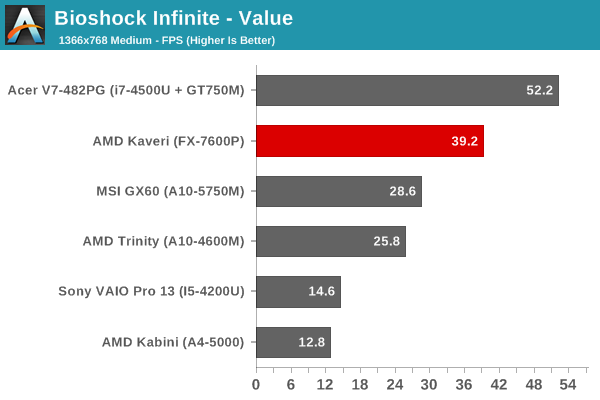
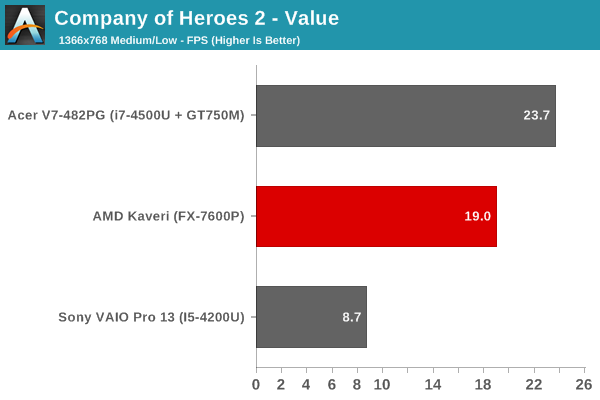
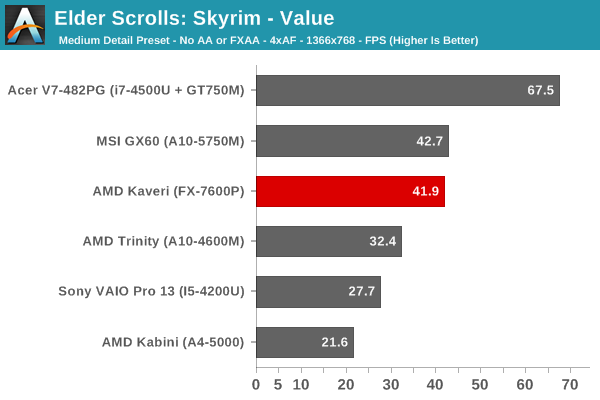
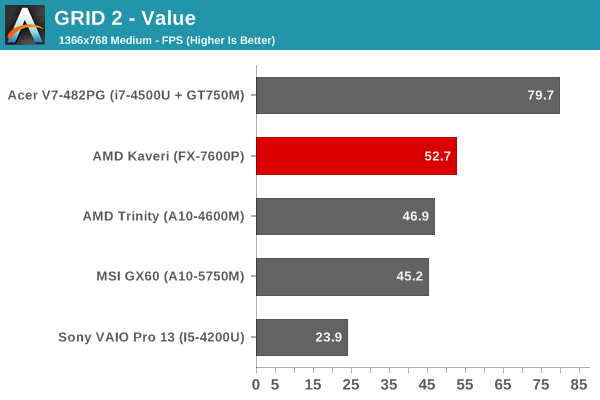

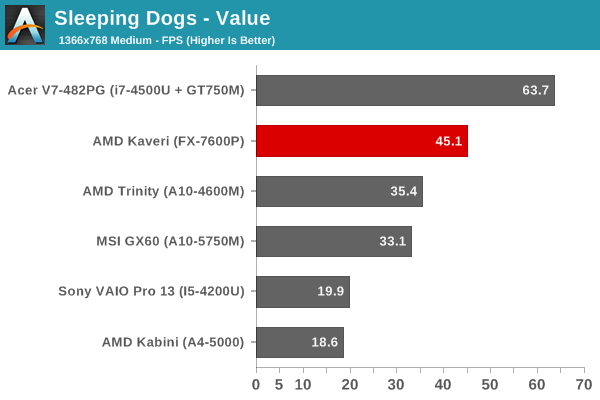
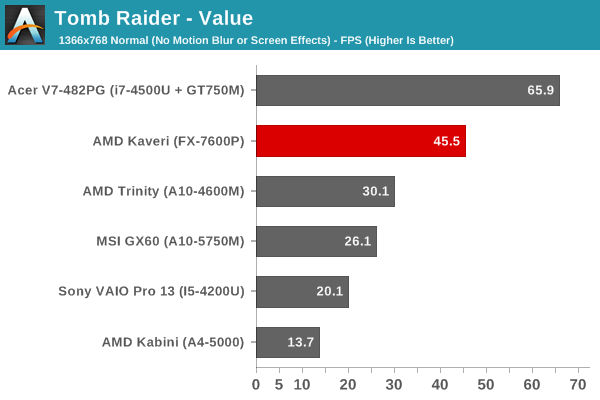
As expected, in most of the tests the Kaveri APU is able to surpass the gaming performance of every other iGPU, and in some cases it even comes moderately close to a discrete mainstream dGPU. There's a sizeable gap between the Trinity/Richland APUs and Kaveri in most of the games I tested, which is great news for those looking for a laptop that won't break the bank but can still run most modern games.
Getting into the particulars, Skyrim seems to be hitting some bottleneck (possibly CPU, though even then I'd expect Kaveri to be faster than Richland), but the vast majority of games should run at more than 30 FPS. There was one system with a pre-release Mantle driver installed that was running Battlefield 4 reasonably well at low/medium details, and with shipping laptops and drivers (and perhaps DDR3-2133 RAM) I suspect even Metro might get close to 30 FPS. Of course, we're only looking at the top performance FX-7600P here, so we'll have to see what the various 19W APUs are able to manage in similar tests.










125 Comments
View All Comments
rhx123 - Wednesday, June 4, 2014 - link
I am really confused about the Acer, as according to Ark, the 4500U has no PCIE 16x lane output, how is the 750M attached?http://ark.intel.com/products/75460/Intel-Core-i7-...
TheinsanegamerN - Wednesday, June 4, 2014 - link
It has a single x4 link and dual x2 ink. the 750m would be connected by the x4 link.coburn_c - Wednesday, June 4, 2014 - link
The GPU isn't good enough to game with and the CPU isn't good enough to do anything else with. You'll get half the battery life of the competition and it will get twice as hot. Abject failure.frozentundra123456 - Wednesday, June 4, 2014 - link
Yes, you hit on the crux of the matter. Problem is still that of all APUs, the igp performance is still in limbo: almost there but not quite for gaming, while cpu performance and power consumption trail intel badly. Looking at the gaming tests, looks like one will be limited to 768p, and even then COH (admittedly terribly optimized) is not playable, and we have no tests for demanding games like Watchdogs, Metro LL, or Crysis 3. So one will be stuck with either a crappy 768p screen or playing at non-native resolution for a lot of games. Not to mention, this mobile chip should have come out first instead of being so close to the broadwell mobile launch.silverblue - Wednesday, June 4, 2014 - link
You say "cpu performance and power consumption trail intel badly". There's no real data on the latter apart from TDP values (which, in themselves, aren't an accurate indicator), and the FX-7600P is certainly no slouch when viewing the CPU benchmarks in this preview. Let's not forget that large portion of the die dedicated to the GPU, either - just because it's there, doesn't mean it's being used. Toms had the FX-7600P doing well at GPGPU (it should) and PCMark, less well at physics scores in 3DMark (the competition was a high-end i7) and even worse in Sandra, but we know that doesn't always mean everything; after all, the Core 2 had low memory bandwidth due to having no IMC but was still easily the match of the Phenom II series.This is a preview, so quite why people are expecting numerous tests on 2013/14 titles from a very brief testing period is beyond me. Patience, grasshopper!
Novaguy - Thursday, June 5, 2014 - link
But I suspect you can hit 1080p with an awful lot of 2007~2012 games, making kaveri mobile + 1080p a great humble bundle mobile gaming solution. Now, if they combined it with freesync, you could get away with lower frame rates and play even more recent games.The_Assimilator - Thursday, June 5, 2014 - link
The use case for a laptop is simple: you don't require graphics horsepower the majority of the time. Hence it makes more sense to use a CPU that uses less power (and performs better), and pair it with a discrete GPU that won't be drawing any power most of the time. Intel understands this and it's why they make money.AMD on the other hand, have dreamed up a mythical future reality where everyone who buys a laptop expects it to deliver decent GPU performance. But very few people buy laptops to play games on, they buy laptops to be productive while mobile - and faster CPU that use less battery power are always going to win out.
nemi2 - Wednesday, June 4, 2014 - link
It's becoming more of a glaring omission as time progresses that AMD doesn't have a SSD caching option in their SATA BIOS/drivers. AMD is targeting the cheaper end of notebooks so I agree with the author: a pure SSD storage solution will not make the BOM, and because there is no AMD SSD caching solution a 8,16,32GD SSD cache can't make the BOM either - discrete chece is not supported and a hybrid HD unfortunately also seem to also command a $ premium and don't have as good integration with windows.Makes me wonder what the state of USB "ready boost" is with Windows these days?, things are very quiet on the that front. Also where is a cheap / free 3rd party utility to provide SSD/ NVM caching, do AMD laptop vendors have any budget / driver solution?
lmcd - Wednesday, June 4, 2014 - link
The SSD caching probably explains it -- thanks for posting (not an obvious conclusion to reach!)JarredWalton - Wednesday, June 4, 2014 - link
SSD caches are really only good for two things:1) Inflate certain benchmark scores (PCMark being a major one).
2) Help laptop boot/resume faster.
Seriously, most other tasks that hit the storage hard -- installing an application, loading a bunch of apps at once, opening a browser with 30 active tabs -- are all only slightly faster than an HDD with SSD caching, where a pure SSD is substantially faster. The best SSD caching solution right now comes from Apple, and it's only good because it's 64GB or more; 24/32GB SSD caches just don't cut it in my experience.